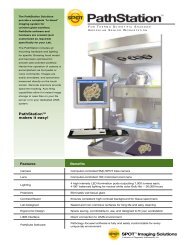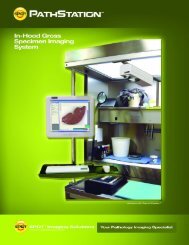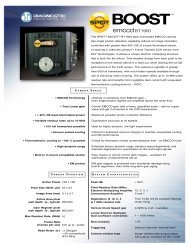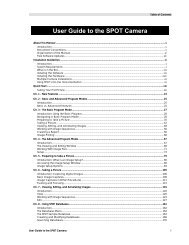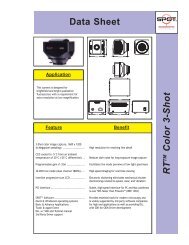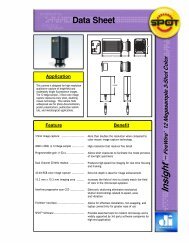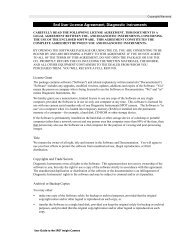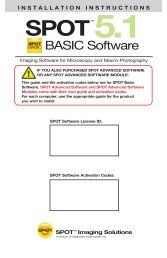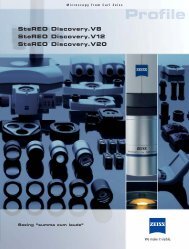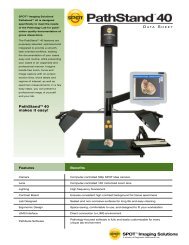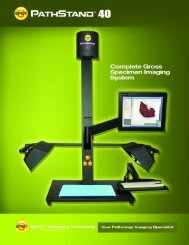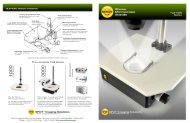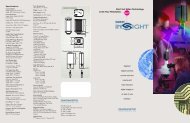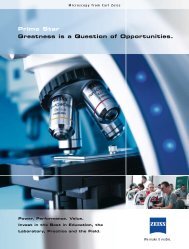optical interference filters - SPOT Imaging Solutions
optical interference filters - SPOT Imaging Solutions
optical interference filters - SPOT Imaging Solutions
You also want an ePaper? Increase the reach of your titles
YUMPU automatically turns print PDFs into web optimized ePapers that Google loves.
application note Optimizing Filter Sets for FRET Applications<br />
While this third filter configuration allows for the discreet collection<br />
of donor and acceptor fluorescence, it is the configuration most<br />
susceptible to the time and image registra tion variables mentioned<br />
previously. The time variable can be minimized as a result of the<br />
automated turrets, which are a standard feature on many new<br />
microscopes but may not be typical on older, installed models. In<br />
addition, alignment of <strong>filters</strong> within cube tol erances allows more<br />
room for registration error than in the two other configurations.<br />
The time and resolution variables that are inherent with this<br />
configuration must be thoughtfully weighed when using a spatially<br />
and temporally sensitive technique such as FRET.<br />
Fluorophore Pairs<br />
While certain fluorophore pairs such as CFP/YFP, have dominated<br />
the scientific litera ture and provided the foundation for suc cessful<br />
FRET studies to date, there has been continued development of<br />
new monomeric fluorescent proteins such as Midoriishi Cyan and<br />
Kusabira Orange, for FRET experiments. These fluorophore developments<br />
have been stimulated by the refine ment of procedures and<br />
ratio correction techniques, as well as microscopy applica tions that<br />
are FRET friendly.<br />
On the most basic level, the success of any given pair of fluorophores<br />
centers on their spectral characteristics. First, there must be<br />
sufficient separation of excitation spectra for selective stimulation<br />
of the donor. Second, there must be sufficient overlap (>30%)<br />
between the emission spectrum of the donor and the excitation<br />
spectrum of the acceptor in order to obtain efficient energy transfer.<br />
And third, there must be sufficient separa tion of the donor and the<br />
acceptor emission spectra so that the fluorescence of each fluorophore<br />
can be collected independently.<br />
Development of new fluorescent proteins has centered on meeting<br />
these criteria, while producing new colors and fluorophores that<br />
bind to varied proteins and biological mole cules. The newest<br />
developments are cited in the links and references to recent<br />
literature listed below:<br />
Fluorophore References<br />
• Wallrabe, H., and Periasamy, A. (2005) FRET-FLIM microscopy<br />
and spectroscopy in the biomedical sciences. Current Opinion in<br />
Biotechnology. 16: 19-27.<br />
• Karasawa, S., Araki, T., Nagai, T., Mizuno, H., Miyawaki, A. (2004) Cyanemitting<br />
and orange-emitting fluorescent proteins as a donor/acceptor<br />
pair for fluorescence resonance energy transfer. Biochemical Journal,<br />
April 5.<br />
• Shaner, N., Campbell, R., Steinbach, P., Giepmans, B., Palmer,<br />
A., Tsien, R. (2004) Improved monomeric red, orange, and yellow<br />
fluorescent proteins derived from Discosoma sp. red fluorescent protein.<br />
Nature Biotechnology, Vol. 22, Number 12, December. pp.1567-1572.<br />
Fret Filter Sets<br />
The products listed in the catalog include the most commonly<br />
used FRET fluorophore pairs, as well as those recently developed<br />
pairs that are worthy of attention. For each FRET fluorophore pair<br />
the chart lists a filter set that is useful in the emission filter wheel<br />
configuration. These sets are comprised of the exciter and dichroic<br />
for the donor fluo rophore and emitters for both the donor and<br />
acceptor fluorophores.<br />
Individual filter set part numbers for both donor and acceptor<br />
fluorophores are also listed so components can be purchased<br />
indi vidually, dependent on the specifics of the hardware set-up. If<br />
purchasing <strong>filters</strong> individ ually, it is important to remember that the<br />
exciter and dichroic from the acceptor fluo rophore set are never<br />
used.<br />
It is important that you provide hardware details and related<br />
mounting instructions when ordering <strong>filters</strong> for FRET applications.<br />
Omega Optical<br />
90<br />
For current product listings, specifications, and pricing:<br />
www.omega<strong>filters</strong>.com • sales@omega<strong>filters</strong>.com<br />
1.866.488.1064 (toll free within USA only) • +1.802.254.2690 (outside USA)



